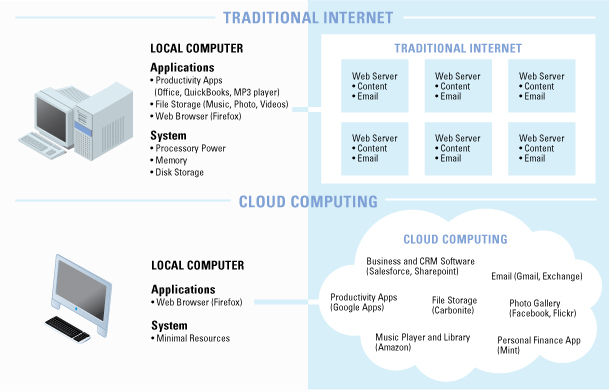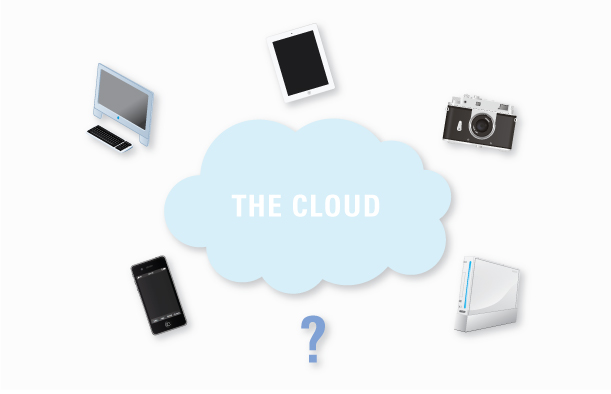Cloud Computing
In the simplest technical sense, cloud computing refers to the use of a network to provide on demand access to data and data processing applications. But this definition differs little if at all from the concept of the World Wide Web as it has existed for almost two decades. Indeed, the websites, email, and online database interfaces that we use every day all qualify as cloud computing in this sense.
Much like ‘blogging’ or ‘Web 2.0’, ‘cloud computing’ is a buzzword that is more indicative of an evolving approach to how the Internet is used rather than a technology unto itself. What defines the cloud computing trend is the migration of data storage and application services that have traditionally resided on end-user hardware to the Internet. From an end-user perspective, this represents an evolution of the Internet from a ‘dumb network’ simply linking user to user, to a highly configurable and ubiquitous source of data and services.
With this in mind, the National Institute of Standards and Technology provides this definition:
“Cloud computing is a model for enabling convenient, on-demand network access to a shared pool of configurable computing resources (e.g., networks, servers, storage, applications, and services) that can be rapidly provisioned and released with minimal management effort or service provider interaction.”
This trend will have powerful ramifications for many industries, including hardware manufacturers, software developers, data security and privacy providers, IT consultants, online communications professionals, and others.
What do people mean when they refer to the cloud?
The concept of the “cloud” originated in the telephone industry and was used to distinguish the line between the responsibility of telecommunication provider and that of the customer.
With respect to computing, “the cloud” really has no different specific technical definition but ostensibly, it may be used to describe the entirety of data, applications and other resources available throughout a particular network. It is also increasingly being used as a marketing term when referring to advanced services.
The “Intercloud” extends the concept of cloud computing globally. This refers to a “cloud of clouds” sharing data, applications and resources, similar to the Internet as a “network of networks.”
How does this differ from the traditional concept of the Internet?

How does cloud computing work?
Cloud computing structure has two major components, the front-end and the back-end, which correspond with the end user and network-based service providers.
Front End
- Computer terminals: Hardware devices need not possess the processing power or range software packages that they have in the past, because they’ll be getting these from the network. Netbooks and smartphones are examples of devices that are cloud-oriented.
- Access software: Software to access the data, applications and other services provided through the cloud. Web browsers, email clients, and phone apps are examples of such software. A fully-cloud enabled device would theoretically use just one web browser to access all online services.
Back End
- Servers and data storage devices: Hardware within the cloud that provides access to data, applications and processing power. A website server is a very basic example of a back end resource, however in most cases cloud computing will be utilizing a network of devices each playing a particular function.
- Administrative servers and protocols: Communication between network elements must still be organized as it has been on the Internet through a network of servers that handle traffic management according to IP protocols.
Devices and the Cloud

Examples of cloud-based services
Applications provided in a cloud-based environment are also know as Software as a Service (SaaS). Some examples are:
- Google Apps: Word processing, spreadsheet and other productivity applications.
- Amazon Cloud Drive: Online file storage, including for media files purchased through the Amazon store, thus creating a cloud-based music collection that can be played through Amazon Cloud Player.
- Mint: A personal money-management service that integrates daily budget data with bank accounts, investments and other financial information.
- Facebook: Personal networking program which provides data and media storage and distribution as well as applications.
- Microsoft Sharepoint: Online work collaboration system.
- Salesforce: Cloud-based customer relationship management (CRM) software.
- Carbonite: Online automatic file-backup system.
Cloud Computing Costs and Benefits
The move towards cloud computing has at least in part been driven the pursuit of more efficient hardware implementations by larger operators such as Amazon, Microsoft and AT&T, as well as by product innovation by end-user providers such as Google. Combined, some of the perceived benefits of cloud computing include:
- Potentially ubiquitous access to data and applications regardless of location of user;
- Potentially reduced costs for both consumers and providers, including hardware, software and IT services;
- Opportunity for device innovation due to reduced need for onboard computing power;
- Opportunity for innovation in end-user applications (e.g., mobile application markets);
- Shared-processing power/grid computing system processing power.
But cloud computing is not without its potential drawbacks, which may include:
- Threat of major security breaches due to consolidation of data and services;
- Risk of widespread application outages;
- Reduced ability for end users to maintain privacy;
- Increased reliance on network connectivity for productivity;
Unanswered Questions
In addition, the evolution of cloud computing raises some as yet unanswered questions:
- Who owns the data in a cloud system, the end user or the service provider?
- Is there a need for standardization in order to facilitate integration of data and apps, and if so, how will that come about?
- Increased centralization of data and software is a move away from the original philosophy of the World Wide Web. Will this move ultimately limit the de facto ability of end users to participate as more than consumers? What long term effects on innovation and security will this have?
Resources
http://en.wikipedia.org/wiki/Cloud_computing
http://computer.howstuffworks.com/cloud-computing.htm
http://www.pcmag.com/article2/0,2817,2372163,00.asp
http://www.google.com/apps/intl/en/business/index.html
https://www.mint.com/
http://www.facebook.com
https://www.amazon.com/clouddrive/learnmore
http://sharepoint.microsoft.com/en-us/Pages/default.aspx
http://www.infoworld.com/d/cloud-computing/what-cloud-computing-really-means-031?page=0,0
http://cloudtimes.org/top-7-cloud-based-service-offerings/

